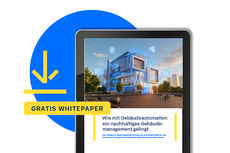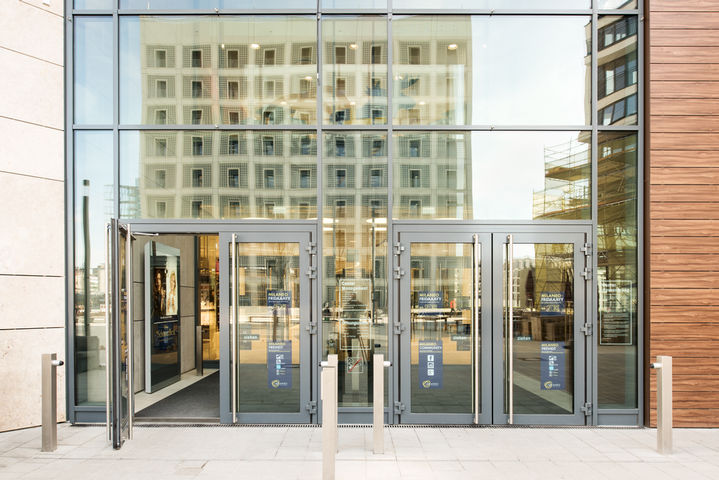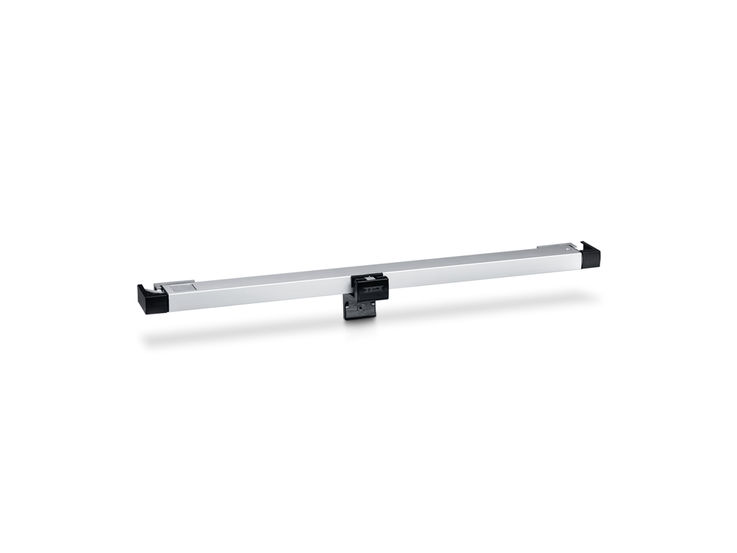Energy efficiency in the building area
When they think of the energy revolution, many people think first about using renewable energy sources. However, at the same time it is important to reduce energy consumption. Buildings offer a high potential for saving energy, since they are the cause of around 35 percent of Germany's total energy consumption. Making buildings more energy efficient by optimising their energy consumption in operation is an important key to reducing consumption in a sustainable way. That means energy efficiency is essential for everyone from architects and planners to operators and final users.
Reducing CO2 emissions is the goal
Warm rooms in the winter, cooling in the summer, lighting at night, quick means of transportation, operating machinery and equipment – it takes a lot of energy to live the way we do. However, the majority of our power supply comes from fossil fuels, and burning these fuels generates CO2 emissions. Today, we know that this is very likely a cause for the alarming pace at which climate change is advancing.
Climate protection targets
The following binding targets were established for Germany under the Federal Climate Protection Act (Bundes-Klimaschutzgesetz (KSG)) of 24/06/2021:
- Greenhouse gas reduction of 65 percent compared to 1990 levels by 2030
- Greenhouse gas neutrality by 2045
Total energy needs and heat loss

Thermal image of a façade: A lot of energy is being lost here! © shutterstock
Building policy plays a key role in the building area in Germany's modern energy policy. Over a third of total final energy consumption is currently used up by buildings – for hot water, heating and cooling, ventilation and illumination. Often, a majority of heat indoors escapes out through the walls, windows, roofs, doors, or floors.
Therefore, in the future, passive efficient houses and nearly zero energy buildings (abbreviated “NZEB”) will be used as the standard reference buildings across the EU. This is stipulated in the amended EU guidelines on overall building energy efficiency (“Energy Performance of Buildings Directive”, abbreviated EPBD). It will initially apply only to new buildings, but all buildings, including existing buildings and non-residential buildings, are supposed to be climate-neutral by 2045. On the one hand, it will be necessary to significantly reduce the energy needed for heating and cooling these zero emission buildings (abbreviated ZEB) during their construction and renovation. On the other, the percentage of renewable energy used to cover remaining needs must be significantly increased.
High energy stipulations under building laws and regulations
In the past, EU guidelines on overall building energy efficiency have been implemented in Germany through the Energy Savings Act (Energieeinsparungsgesetz (EnEG)), the Energy Savings Regulation (Energieeinsparungsverordnung (EnEV)) and the Renewable Energy Heating Act (Erneuerbare-Energien-Wärmegesetz (EEWärmeG)). As of 1 November 2020, these regulations were combined under the Building Energy Act (Gebäudeenergiegesetz (GEG)).
The laws and regulations stipulate energy limit values and energy certificates, with definitions of energy efficiency classes for new and existing buildings. The goal is to keep the primary energy requirements of buildings low. This, in turn, will limit the energy lost by buildings from the outset through structural thermal insulation – in particular through good insulation, good windows, and avoiding thermal bridges. Remaining energy needs will thus be kept as low as possible, and more of those needs will be covered by renewable energy sources as time goes by.
Better energy efficiency through building automation
Many studies, such as the Bitkom study on climate protection and energy efficiency, show that, besides the traffic sector and industrial production, buildings are one of the biggest producers of CO2 emissions, and are the origin for around 1/3 of Germany's total energy needs. According to the study, the biggest potential energy savings for residential and non-residential buildings lie in smart building and intelligent building automation. It is possible to achieve comfort for working and living while ensuring good energy efficiency, for example, through intelligently controlling heating, hot water, lighting, and ventilation technology. These controls must be adjusted specifically to the building's characteristics and user behaviour. Ideally, in the future buildings would be able to adapt to changing conditions via digitisation and automation – to the number of people present in the building, as well as the weather conditions.
Good to know: Standard DIN EN 15232 defines the efficiency classes for different building automation functions and applications. This allows for more reliable estimates of potential energy and CO2 savings.

Download white paper
You can learn more about building automation and its influence on sustainability in our white paper.
Download white paper on building automation now
GEZE products for energy-efficient buildings
With integrated solutions for door, window, and safety technology focused on energy efficiency, it is possible to combine comfort and safety with energy efficiency in a smart way. Interdisciplinary networking also creates all new options for energy-saving building management. GEZE makes a significant contribution to energy efficiency through different products and solutions:
- natural ventilation and exhaust of buildings, as well as single room temperature control via automated window systems
- automatic opening and reliable closing of doors
- myGEZE Control intelligent building automation system for smart integration of door, window, and safety technology into the building automation system. Depending on the outside temperature, for example, the opening widths of doors can be adjusted automatically or windows can be opened or closed accordingly in coordination with temperature sensors and heating systems.
Saving energy with natural ventilation
Natural building ventilation saves a significant amount of energy and resources and eliminates the need for energy-intensive air conditioning systems. Mechanical air conditioning systems require a very large amount of energy. In addition to the large area they take up in the building, which is no longer available for other uses, high investment, maintenance and operating costs make such systems seem an unprofitable choice. Regulated natural ventilation, in contrast, is clearly an advantage. “Intelligent” drives and control panels from GEZE that can be used to open and close façade and roof windows in a controlled manner ensure energy-saving and environmentally-friendly ventilation and exhaust. For instance, they facilitate automatic night-time cooling, which is a cost- and energy-efficient method for cooling buildings compared to an air conditioning system.
Comfortable building automation for better energy efficiency
GEZE technology can be used to control façade elements, whether doors or windows, based on current needs. Each window can be controlled individually. Temperature and CO2 sensors, timers and rain-wind sensors open and close windows automatically. The new myGEZE Control building automation system can also be used to centrally visualise, control and manage automatic doors and windows.
At GEZE, we have understood that buildings make an important contribution to sustainably reducing energy consumption and therefore CO2 emissions. That’s why smart and energy-saving solutions are more than ever the focus for our customers and us.
Sandra Alber, Chief Officer Legal & Finance
The DGNB certification system assesses a building’s level of sustainability.
More than energy efficiency: sustainable building (green building)
GEZE is facilitating sustainable building, also known as “green building” through its products. Green building means modern, sustainable environmentally-friendly building construction and renovation in harmony with humans and nature. The buildings stand out for their efficient use of resources such as energy, water, and materials. At the same time, harmful impacts on health and the environment are also reduced. The guiding principle of sustainability is pursued throughout the complete building life cycle as far as possible, starting from project development, planning, and design to operation and maintenance and to disassembly. A seal was created in Germany in 2007 to reflect this: The certificate of the German Suistainable Building Council (DGNB).
Honoured with the DGNB certificate for sustainability
In the new corporate building of Vector IT in Stuttgart, our customised digital networking solutions help to avoid a total of approximately 460 tons of CO2 emissions per year in ongoing operations. The German Suistainable Building Council awarded the project the DGNB platinum certificate as well as the DGNB diamond for outstanding architecture for this achievement.
Around 120 buildings have already received the DGNB certificate or a previous certificate. These include the building of the Umweltbundesamt Dessau (UBA - German Environment Agency), which is a flagship project of the German state due to the high level of quality it achieves in all aspects of sustainable building, and is one of Germany's most efficient administrative buildings. The door technology in the building comes from GEZE.
Read more about green building
Read more about building renovation

Combining digital building planning and sustainability: BIM makes it possible
From investors to architects, specialist planners, installation companies, system vendors, or building product manufacturers: everyone benefits when planning and collaboration are simplified. The same is true for achieving climate targets: Innovative, environmentally-aware and resource-saving solutions are essential to reduce CO2 emissions in the building sector. Building Information Modelling (BIM) facilitates comprehensive, integrated planning. From the draft of a building to its dismantling, it can be used to pursue sustainable project targets and strategies. Because of this, BIM has great potential for helping use resources and building materials in an environmentally-friendly way throughout the entire building life cycle. It can also help reduce the work required for DGNB certification, which saves time, money, and resources.
Become an expert with our free BIM white paper!




